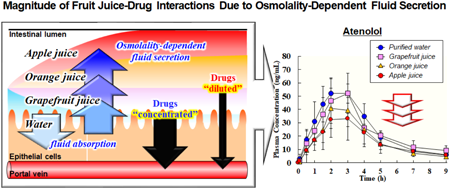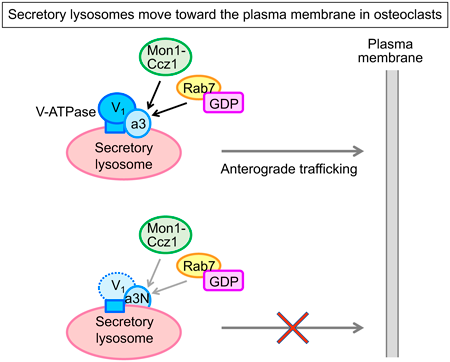- |<
- <
- 1
- >
- >|
-
2024Volume 47Issue 1 Pages 1-13
Published: January 01, 2024
Released on J-STAGE: January 01, 2024
Download PDF (4885K) Full view HTML
-
2024Volume 47Issue 1 Pages 14-22
Published: January 01, 2024
Released on J-STAGE: January 01, 2024
Advance online publication: October 25, 2023Download PDF (2323K) Full view HTML
-
2024Volume 47Issue 1 Pages 23-27
Published: January 01, 2024
Released on J-STAGE: January 01, 2024
Download PDF (2985K) Full view HTML
-
 2024Volume 47Issue 1 Pages 28-36
2024Volume 47Issue 1 Pages 28-36
Published: January 01, 2024
Released on J-STAGE: January 01, 2024
Editor's pickPyroptosis is a type of regulated cell death, and its dysregulation is detrimental and implicated in various diseases. The authors screened chemical compounds and identified azalamellarin N (AZL-N), a hexacyclic pyrrole alkaloid, as an inhibitor of pyroptosis induced by the intracellular multiprotein complex NLRP3 inflammasome. The inhibitory effects of AZL-N differed depending on the type of stimulus, which was different from those of MCC950, a well-established NLRP3 inhibitor. Considering that many studies have been focusing on the general mechanisms of NLRP3 inflammasome-dependent pyroptosis, AZL-N is a unique tool for uncovering the differential mechanisms of pyroptosis depending on the type of inflammatory stimulus.
Download PDF (2585K) Full view HTML -
2024Volume 47Issue 1 Pages 37-42
Published: January 01, 2024
Released on J-STAGE: January 01, 2024
Download PDF (1944K) Full view HTML -
2024Volume 47Issue 1 Pages 43-48
Published: January 01, 2024
Released on J-STAGE: January 01, 2024
Advance online publication: November 10, 2023Download PDF (546K) Full view HTML -
2024Volume 47Issue 1 Pages 49-59
Published: January 01, 2024
Released on J-STAGE: January 01, 2024
Download PDF (16629K) Full view HTML -
 2024Volume 47Issue 1 Pages 60-71
2024Volume 47Issue 1 Pages 60-71
Published: January 01, 2024
Released on J-STAGE: January 01, 2024
Advance online publication: November 03, 2023Editor's pickThe article by Oyama et al. suggested a novel mechanism of radiation-induced acquisition of malignant profile in lung cancer. Authors have shown that activation of adenosine A2B receptor and cannabinoid receptors (CB1, CB2 and GPR55) are involved in enhancement of cell migration after g-irradiation in A549 cells. And authors have shown that enhancement of cell migration by activation of adenosine A2B receptor is mediated by activation of CB2 and GPR55 receptor. These findings proposed that the A2B-CB2 and A2B-GPR55 pathways contributes to the radiation-induced acquisition of malignant profile in lung cancer and could be a novel molecular target to improve the efficiency of radiation therapy for lung cancer.
Download PDF (12274K) Full view HTML -
 2024Volume 47Issue 1 Pages 72-78
2024Volume 47Issue 1 Pages 72-78
Published: January 01, 2024
Released on J-STAGE: January 01, 2024
Editor's pickThe authors revealed that changes in gastrointestinal fluid volume due to solution osmolality can explain the differences in the magnitude of beverage-drug interactions depending on the type of beverage. Osmolality-dependent fluid secretion and consequent decrease in luminal concentrations and absorption of drugs were observed in the rat intestine after administration of apple juice, orange juice, and grapefruit juice. Further, in vivo oral experiments showed that plasma concentrations of atenolol, a low-permeability drug, after oral administration decreased in dependence upon the magnitude of osmolality of ingested beverages, while the plasma concentrations of antipyrine, a high-permeability drug, did not change.
Download PDF (685K) Full view HTML -
2024Volume 47Issue 1 Pages 79-87
Published: January 01, 2024
Released on J-STAGE: January 01, 2024
Download PDF (1089K) Full view HTML -
2024Volume 47Issue 1 Pages 88-97
Published: January 01, 2024
Released on J-STAGE: January 01, 2024
Download PDF (368K) Full view HTML -
2024Volume 47Issue 1 Pages 98-103
Published: January 01, 2024
Released on J-STAGE: January 01, 2024
Download PDF (356K) Full view HTML -
 2024Volume 47Issue 1 Pages 104-111
2024Volume 47Issue 1 Pages 104-111
Published: January 01, 2024
Released on J-STAGE: January 01, 2024
Editor's pick[Highlighted Paper selected by Editor-in-Chief]
Chronic cerebral hypoperfusion can cause white matter lesions, leading to vascular dementia. Recently, these diseases have been reported to be associated with lipid peroxidation. In this research, the authors revealed that ethoxyquin, a lipid-soluble antioxidant, had a protective effect against a glutamate-stimulated mouse hippocampal cell line and was comparable to the ferroptosis inhibitor. Additionally, when applied to a mouse model of chronic cerebral hypoperfusion, ethoxyquin suppressed white matter lesions and inflammatory responses. Overall, the authors demonstrated that inhibiting lipid peroxidation could be a helpful therapy for chronic cerebrovascular disease.Download PDF (2667K) Full view HTML -
2024Volume 47Issue 1 Pages 112-119
Published: January 01, 2024
Released on J-STAGE: January 01, 2024
Advance online publication: November 16, 2023Download PDF (519K) Full view HTML -
2024Volume 47Issue 1 Pages 120-129
Published: January 01, 2024
Released on J-STAGE: January 01, 2024
Download PDF (10226K) Full view HTML -
2024Volume 47Issue 1 Pages 130-137
Published: January 01, 2024
Released on J-STAGE: January 01, 2024
Advance online publication: November 21, 2023Download PDF (1235K) Full view HTML -
2024Volume 47Issue 1 Pages 138-144
Published: January 01, 2024
Released on J-STAGE: January 01, 2024
Download PDF (962K) Full view HTML -
2024Volume 47Issue 1 Pages 145-153
Published: January 01, 2024
Released on J-STAGE: January 01, 2024
Download PDF (3273K) Full view HTML -
2024Volume 47Issue 1 Pages 154-158
Published: January 01, 2024
Released on J-STAGE: January 01, 2024
Advance online publication: October 25, 2023Download PDF (791K) Full view HTML -
2024Volume 47Issue 1 Pages 159-165
Published: January 01, 2024
Released on J-STAGE: January 01, 2024
Download PDF (700K) Full view HTML -
2024Volume 47Issue 1 Pages 166-174
Published: January 13, 2024
Released on J-STAGE: January 13, 2024
Download PDF (8243K) Full view HTML -
2024Volume 47Issue 1 Pages 175-186
Published: January 13, 2024
Released on J-STAGE: January 13, 2024
Advance online publication: December 13, 2023Download PDF (14471K) Full view HTML
-
2024Volume 47Issue 1 Pages 187-191
Published: January 16, 2024
Released on J-STAGE: January 16, 2024
Download PDF (2776K) Full view HTML -
2024Volume 47Issue 1 Pages 192-195
Published: January 16, 2024
Released on J-STAGE: January 16, 2024
Download PDF (1291K) Full view HTML
-
2024Volume 47Issue 1 Pages 196-203
Published: January 19, 2024
Released on J-STAGE: January 19, 2024
Download PDF (5015K) Full view HTML -
2024Volume 47Issue 1 Pages 204-212
Published: January 19, 2024
Released on J-STAGE: January 19, 2024
Download PDF (4545K) Full view HTML -
2024Volume 47Issue 1 Pages 213-220
Published: January 20, 2024
Released on J-STAGE: January 20, 2024
Advance online publication: December 07, 2023Download PDF (1102K) Full view HTML -
2024Volume 47Issue 1 Pages 221-226
Published: January 20, 2024
Released on J-STAGE: January 20, 2024
Download PDF (2280K) Full view HTML
-
2024Volume 47Issue 1 Pages 227-231
Published: January 20, 2024
Released on J-STAGE: January 20, 2024
Download PDF (573K) Full view HTML
-
2024Volume 47Issue 1 Pages 232-239
Published: January 20, 2024
Released on J-STAGE: January 20, 2024
Download PDF (824K) Full view HTML
-
2024Volume 47Issue 1 Pages 240-244
Published: January 20, 2024
Released on J-STAGE: January 20, 2024
Download PDF (744K) Full view HTML
-
 2024Volume 47Issue 1 Pages 245-252
2024Volume 47Issue 1 Pages 245-252
Published: January 20, 2024
Released on J-STAGE: January 20, 2024
Advance online publication: December 14, 2023Editor's pickLecithin reverse wormlike micelles (LRWs) are highly viscoelastic bodies and potentially useful for transdermal applications. The authors prepared LRWs with 6-carboxyfluorescein (CF) as a model for a hydrophilic drug, and investigated the effect of the rheological properties and composition of LRWs on the skin permeation of CF. The highest skin permeability of CF was observed when IPM was used as the oil, and the penetration of CF into hair follicles is influenced not only by the rheology of the formulation but also by the interaction between IPM and sebum in the hair follicles.
Download PDF (2324K) Full view HTML
-
2024Volume 47Issue 1 Pages 253-258
Published: January 24, 2024
Released on J-STAGE: January 24, 2024
Download PDF (4735K) Full view HTML
-
2024Volume 47Issue 1 Pages 259-271
Published: January 24, 2024
Released on J-STAGE: January 24, 2024
Advance online publication: December 16, 2023Download PDF (4758K) Full view HTML -
2024Volume 47Issue 1 Pages 272-278
Published: January 24, 2024
Released on J-STAGE: January 24, 2024
Download PDF (3019K) Full view HTML -
2024Volume 47Issue 1 Pages 279-291
Published: January 26, 2024
Released on J-STAGE: January 26, 2024
Advance online publication: December 06, 2023Download PDF (7375K) Full view HTML -
2024Volume 47Issue 1 Pages 292-302
Published: January 26, 2024
Released on J-STAGE: January 26, 2024
Download PDF (11663K) Full view HTML -
2024Volume 47Issue 1 Pages 303-310
Published: January 26, 2024
Released on J-STAGE: January 26, 2024
Download PDF (5281K) Full view HTML -
2024Volume 47Issue 1 Pages 311-317
Published: January 27, 2024
Released on J-STAGE: January 27, 2024
Download PDF (7218K) Full view HTML -
2024Volume 47Issue 1 Pages 318-327
Published: January 27, 2024
Released on J-STAGE: January 27, 2024
Advance online publication: December 27, 2023Download PDF (1618K) Full view HTML
-
2024Volume 47Issue 1 Pages 328-333
Published: January 31, 2024
Released on J-STAGE: January 31, 2024
Download PDF (832K) Full view HTML -
2024Volume 47Issue 1 Pages 334-338
Published: January 31, 2024
Released on J-STAGE: January 31, 2024
Advance online publication: December 22, 2023Download PDF (3283K) Full view HTML -
2024Volume 47Issue 1 Pages 339-344
Published: January 31, 2024
Released on J-STAGE: January 31, 2024
Download PDF (2427K) Full view HTML
- |<
- <
- 1
- >
- >|











































